A Cost-Effective Fault Diagnosis and Localization Approach for Utility-Scale PV Systems Using Limited Number of Sensors
Abstract
:1. Introduction
2. Fault Analysis of a Multiple String PV Array
2.1. Configuration of the Considered Utility-Scale PV System
2.2. Definition of Fault Analysis Variables
- Open-circuit test voltage (VOT): The PV array voltage under an open-circuit condition.
- Short-circuit test current (IST): The PV array current under a short-circuit test condition.
- Maximum test power (PMT): The PV array power under the MPPT test condition.
- String difference voltage (UXY): The voltage difference between each of the two neighboring strings. For this test, the voltage of a PV string is measured at the positive node of the top module of the string and prior to the series blocking diode.
- Fault voltage (VF): The resultant abnormal voltage at where the fault event occurs.
- Fault current (IF): The resultant current flowing through the fault path.
- Fault resistance (RF): The accumulated DC resistance of the fault path.
- Diode forward voltage drop (VDF).
2.3. PV Array Fault Analysis
2.3.1. Line-to-Ground Fault
2.3.2. Module Fault
2.3.3. Partial-Shading
2.3.4. Open-Circuit Fault
3. PV System Modeling and Considered PV Faults
3.1. PV Panel Model and Characteristics
3.2. Considered PV Array Faults
4. Fault Detection and Localization Approach
4.1. Placing of Strings-Difference Voltage Sensors
4.2. Selectively Designed Tests
4.3. Faults Classification
5. Estimation of PV Power Based on Captured Solar Irradiance Energy
5.1. Estimation of the Solar Radiation Energy
- The direct radiation beam, which is represented by the solar radiation energy on a flat surface (I0).
- The surface orientation is where the surface tilt and azimuth angles are considered. The impact of different surface orientations is included in the orientation coefficient (CR). This factor varies from 0 to 1, where CR = 1 when the collector surface is flat to the ground.
- The radiation view factor between the sky and the collector FRS, and it is included to measure how far the surface is facing the sky. This factor varies from 0.5 to 1, where its lowest value occurs when the tilt angle of the collector is 90°.
- The level of collected scattered radiation, where it can be included via the radiation view factor between the ground and collector FRg. This factor principally measures how the collecting surface is facing the ground. It varies from 0 to 0.5, where its lowest value occurs when the collector surface is flat to the ground.
- The sky condition index (KT), which concerns about the weather condition. This index varies from 0 to 1, where its highest value occurs in the case of a clear sky. The constant K is dependent on the sky condition index and can be obtained as in Equation (6).
- The capability of the ground to reflect the sun’s radiation, which can be accounted via the ground reflectance factor μg. This factor varies from 0 to 1, where its lowest value occurs in the absence of scattered radiation. Normally, this factor is set at 0.6 during the winter season and 0.2 for the rest of the year.
5.2. Estimation of the PV Output Power
6. Case Study Results and Discussion
6.1. Validation of the PV Power Estimation Model
6.2. Validation of the Proposed Fault Detection and Classification Methodology
6.2.1. Line-to-Ground and Inter-String Module Faults
6.2.2. Open-String Fault
6.2.3. Partial Shading
| Fault Type | RF (Ω) | U12O (V) | PMT (kW) | VOCT (V) | ISCT (A) | NOS | I–V Curve | ||
|---|---|---|---|---|---|---|---|---|---|
| Combiner box | NA | 0 | 0 | 0 | 0 | NA | NA | ||
| L–G | w/LRF | 0 | 118.6 | 18.86 | 236.8 | 114.2 | 1 | NA | |
| 4 | 72.95 | 18.89 | 236.8 | 114.2 | 1 | NA | |||
| w/HRF | 8 | 28.72 | 19.36 | 236.8 | 114.2 | 0 | Figure 20 | ||
| 10 | 17.44 | 19.58 | 236.8 | 114.2 | 0 | ||||
| Module | w/LRF | 0 | 39.58 | 18.86 | 236.8 | 114.2 | 1 | NA | |
| 0.1 | 39.02 | 18.88 | 236.8 | 114.2 | 1 | NA | |||
| w/HRF | 8 | 1.814 | 19.59 | 236.8 | 114.2 | 0 | Figure 20 | ||
| 10 | 1.013 | 19.72 | 236.8 | 114.2 | 0 | ||||
| Open-string | NA | 0 | 18.86 | 236.8 | 102.7 | 1 | NA | ||
| Partial shading | 50% | NA | 1.306 | 20.30 | 236.8 | 114.2 | 0 | Figure 22 | |
| 25% | NA | 2.617 | 19.94 | 236.8 | 114.2 | 0 | |||
| Healthy | NA | 0 | 20.91 | 236.8 | 114.2 | 0 | NA | ||
7. Conclusions
Author Contributions
Funding
Institutional Review Board Statement
Informed Consent Statement
Data Availability Statement
Conflicts of Interest
References
- Chang, R.-D.; Zuo, J.; Zhao, Z.-Y.; Zillante, G.; Gan, X.-L.; Soebarto, V. Evolving Theories of Sustainability and Firms: History, Future Directions and Implications for Renewable Energy Research. Renew. Sustain. Energy Rev. 2017, 72, 48–56. [Google Scholar] [CrossRef]
- Renewable Energy Policy Network for the 21st Century (REN21). REN21’s Renewables Global Status Report (GSR); Renewable Energy Policy Network for the 21st Century (REN21): Paris, France, 2023. [Google Scholar]
- Venkatakrishnan, G.; Rengaraj, R.; Tamilselvi, S.; Harshini, J.; Sahoo, A.; Saleel, C.A.; Abbas, M.; Cuce, E.; Jazlyn, C.; Shaik, S. Detection, Location, and Diagnosis of Different Faults in Large Solar PV System—A Review. Int. J. Low Carbon Technol. 2023, 18, 659–674. [Google Scholar] [CrossRef]
- Al Mahdi, H.; Leahy, P.G.; Alghoul, M.; Morrison, A.P. A Review of Photovoltaic Module Failure and Degradation Mechanisms: Causes and Detection Techniques. Solar 2024, 4, 43–82. [Google Scholar] [CrossRef]
- Yang, C.; Sun, F.; Zou, Y.; Lv, Z.; Xue, L.; Jiang, C.; Liu, S.; Zhao, B.; Cui, H. A Survey of Photovoltaic Panel Overlay and Fault Detection Methods. Energies 2024, 17, 837. [Google Scholar] [CrossRef]
- Joseph, E.; Vijaya Kumar, P.M.; Mahinder Singh, B.S.; Ching, D.L.C. Performance Monitoring Algorithm for Detection of Encapsulation Failures and Cell Corrosion in PV Modules. Energies 2023, 16, 3391. [Google Scholar] [CrossRef]
- Hu, Y.; Zhang, J.; Cao, W.; Wu, J.; Tian, G.Y.; Finney, S.J.; Kirtley, J.L. Online Two-Section PV Array Fault Diagnosis with Optimized Voltage Sensor Locations. IEEE Trans. Ind. Electron. 2015, 62, 7237–7246. [Google Scholar] [CrossRef]
- Dhimish, M.; Holmes, V. Fault Detection Algorithm for Grid-Connected Photovoltaic Plants. Sol. energy 2016, 137, 236–245. [Google Scholar] [CrossRef]
- Hariharan, R.; Chakkarapani, M.; Ilango, G.S.; Nagamani, C. A Method to Detect Photovoltaic Array Faults and Partial Shading in PV Systems. IEEE J. Photovolt. 2016, 6, 1278–1285. [Google Scholar] [CrossRef]
- Yi, Z.; Etemadi, A.H. Line-to-Line Fault Detection for Photovoltaic Arrays Based on Multiresolution Signal Decomposition and Two-Stage Support Vector Machine. IEEE Trans. Ind. Electron. 2017, 64, 8546–8556. [Google Scholar] [CrossRef]
- Yahyaoui, I.; Segatto, M.E. A Practical Technique for On-Line Monitoring of a Photovoltaic Plant Connected to a Single-Phase Grid. Energy Convers. Manag. 2017, 132, 198–206. [Google Scholar] [CrossRef]
- Khoshnami, A.; Sadeghkhani, I. Sample Entropy-based Fault Detection for Photovoltaic Arrays. IET Renew. Power Gener. 2018, 12, 1966–1976. [Google Scholar] [CrossRef]
- Jain, P.; Poon, J.; Singh, J.P.; Spanos, C.; Sanders, S.R.; Panda, S.K. A Digital Twin Approach for Fault Diagnosis in Distributed Photovoltaic Systems. IEEE Trans. Power Electron. 2019, 35, 940–956. [Google Scholar] [CrossRef]
- Harrou, F.; Sun, Y.; Taghezouit, B.; Saidi, A.; Hamlati, M.-E. Reliable Fault Detection and Diagnosis of Photovoltaic Systems Based on Statistical Monitoring Approaches. Renew. Energy 2018, 116, 22–37. [Google Scholar] [CrossRef]
- Kumar, B.P.; Ilango, G.S.; Reddy, M.J.B.; Chilakapati, N. Online Fault Detection and Diagnosis in Photovoltaic Systems Using Wavelet Packets. IEEE J. Photovolt. 2017, 8, 257–265. [Google Scholar] [CrossRef]
- Chen, L.; Li, S.; Wang, X. Quickest Fault Detection in Photovoltaic Systems. IEEE Trans. Smart Grid 2016, 9, 1835–1847. [Google Scholar] [CrossRef]
- Dhar, S.; Patnaik, R.K.; Dash, P. Fault Detection and Location of Photovoltaic Based DC Microgrid Using Differential Protection Strategy. IEEE Trans. Smart Grid 2017, 9, 4303–4312. [Google Scholar] [CrossRef]
- Yi, Z.; Etemadi, A.H. Fault Detection for Photovoltaic Systems Based on Multi-Resolution Signal Decomposition and Fuzzy Inference Systems. IEEE Trans. Smart Grid 2016, 8, 1274–1283. [Google Scholar] [CrossRef]
- Sreelakshmy, J.; Kumar, B.P.; Ilango, G.S.; Nagamani, C. Identification of Faults in PV Array Using Maximal Overlap Discrete Wavelet Transform. In Proceedings of the 2018 20th National Power Systems Conference (NPSC), Tiruchirappalli, India, 14–16 December 2018; pp. 1–6. [Google Scholar]
- El-Banby, G.M.; Moawad, N.M.; Abouzalm, B.A.; Abouzaid, W.F.; Ramadan, E. Photovoltaic System Fault Detection Techniques: A Review. Neural Comput. Appl. 2023, 35, 24829–24842. [Google Scholar] [CrossRef]
- Fadhel, S.; Delpha, C.; Diallo, D.; Bahri, I.; Migan, A.; Trabelsi, M.; Mimouni, M.F. PV Shading Fault Detection and Classification Based on IV Curve Using Principal Component Analysis: Application to Isolated PV System. Sol. energy 2019, 179, 1–10. [Google Scholar] [CrossRef]
- Mehmood, A.; Sher, H.A.; Murtaza, A.F.; Al-Haddad, K. A Diode-Based Fault Detection, Classification, and Localization Method for Photovoltaic Array. IEEE Trans. Instrum. Meas. 2021, 70, 1–12. [Google Scholar] [CrossRef]
- Alhejab, A.; Abbasi, M.; Ahmed, S. A Novel Fault Localization Technique for PV Systems Using a Single-Voltage Sensor. TechRxiv 2024, 12, 42–64. [Google Scholar] [CrossRef]
- Kandeal, A.; Elkadeem, M.; Thakur, A.K.; Abdelaziz, G.B.; Sathyamurthy, R.; Kabeel, A.; Yang, N.; Sharshir, S.W. Infrared Thermography-Based Condition Monitoring of Solar Photovoltaic Systems: A Mini Review of Recent Advances. Sol. energy 2021, 223, 33–43. [Google Scholar] [CrossRef]
- Pierdicca, R.; Paolanti, M.; Felicetti, A.; Piccinini, F.; Zingaretti, P. Automatic Faults Detection of Photovoltaic Farms: solAIr, a Deep Learning-Based System for Thermal Images. Energies 2020, 13, 6496. [Google Scholar] [CrossRef]
- Sinha, A.; Sastry, O.; Gupta, R. Detection and Characterisation of Delamination in PV Modules by Active Infrared Thermography. Nondestruct. Test. Eval. 2016, 31, 1–16. [Google Scholar] [CrossRef]
- Pillai, D.S.; Rajasekar, N. A Comprehensive Review on Protection Challenges and Fault Diagnosis in PV Systems. Renew. Sustain. Energy Rev. 2018, 91, 18–40. [Google Scholar] [CrossRef]
- Li, B.; Delpha, C.; Diallo, D.; Migan-Dubois, A. Application of Artificial Neural Networks to Photovoltaic Fault Detection and Diagnosis: A Review. Renew. Sustain. Energy Rev. 2021, 138, 110512. [Google Scholar] [CrossRef]
- Zhang, D.; Han, X.; Deng, C. Review on the Research and Practice of Deep Learning and Reinforcement Learning in Smart Grids. CSEE J. Power Energy Syst. 2018, 4, 362–370. [Google Scholar] [CrossRef]
- Al-Katheri, A.A.; Al-Ammar, E.A.; Alotaibi, M.A.; Ko, W.; Park, S.; Choi, H.-J. Application of Artificial Intelligence in PV Fault Detection. Sustainability 2022, 14, 13815. [Google Scholar] [CrossRef]
- Herraiz, Á.H.; Marugán, A.P.; Márquez, F.P.G. Photovoltaic Plant Condition Monitoring Using Thermal Images Analysis by Convolutional Neural Network-Based Structure. Renew. Energy 2020, 153, 334–348. [Google Scholar] [CrossRef]
- Amiri, A.F.; Kichou, S.; Oudira, H.; Chouder, A.; Silvestre, S. Fault Detection and Diagnosis of a Photovoltaic System Based on Deep Learning Using the Combination of a Convolutional Neural Network (Cnn) and Bidirectional Gated Recurrent Unit (Bi-GRU). Sustainability 2024, 16, 1012. [Google Scholar] [CrossRef]
- Korkmaz, D.; Acikgoz, H. An Efficient Fault Classification Method in Solar Photovoltaic Modules Using Transfer Learning and Multi-Scale Convolutional Neural Network. Eng. Appl. Artif. Intell. 2022, 113, 104959. [Google Scholar] [CrossRef]
- Veerasamy, V.; Wahab, N.I.A.; Othman, M.L.; Padmanaban, S.; Sekar, K.; Ramachandran, R.; Hizam, H.; Vinayagam, A.; Islam, M.Z. LSTM Recurrent Neural Network Classifier for High Impedance Fault Detection in Solar PV Integrated Power System. IEEE Access 2021, 9, 32672–32687. [Google Scholar] [CrossRef]
- Lu, S.; Sirojan, T.; Phung, B.T.; Zhang, D.; Ambikairajah, E. DA-DCGAN: An Effective Methodology for DC Series Arc Fault Diagnosis in Photovoltaic Systems. IEEE Access 2019, 7, 45831–45840. [Google Scholar] [CrossRef]
- Goodfellow, I.; Pouget-Abadie, J.; Mirza, M.; Xu, B.; Warde-Farley, D.; Ozair, S.; Courville, A.; Bengio, Y. Generative Adversarial Nets. Adv. Neural Inf. Process. Syst. 2014, 3, 163–197. [Google Scholar]
- Alfaris, F.E. A Sensorless Intelligent System to Detect Dust on PV Panels for Optimized Cleaning Units. Energies 2023, 16, 1287. [Google Scholar] [CrossRef]
- Morales-Aragonés, J.I.; Dávila-Sacoto, M.; González, L.G.; Alonso-Gómez, V.; Gallardo-Saavedra, S.; Hernández-Callejo, L. A Review of I–V Tracers for Photovoltaic Modules: Topologies and Challenges. Electronics 2021, 10, 1283. [Google Scholar] [CrossRef]
- Iheanetu, K.J. Solar Photovoltaic Power Forecasting: A Review. Sustainability 2022, 14, 17005. [Google Scholar] [CrossRef]
- Gupta, S.; Singh, A.K.; Mishra, S.; Vishnuram, P.; Dharavat, N.; Rajamanickam, N.; Kalyan, C.N.S.; AboRas, K.M.; Sharma, N.K.; Bajaj, M. Estimation of Solar Radiation with Consideration of Terrestrial Losses at a Selected Location—A Review. Sustainability 2023, 15, 9962. [Google Scholar] [CrossRef]
- Alfaris, F.E.; Almutairi, F. Performance Assessment User Interface to Enhance the Utilization of Grid-Connected Residential PV Systems. Sustainability 2024, 16, 1825. [Google Scholar] [CrossRef]
- Roger, A.; Amir, A. Photovoltaic Systems Engineering, 4th ed.; CRC Press: New York, NY, USA, 2017; pp. 133–356. [Google Scholar] [CrossRef]
- Faheem, M.; Abu Bakr, M.; Ali, M.; Majeed, M.A.; Haider, Z.M.; Khan, M.O. Evaluation of Efficiency Enhancement in Photovoltaic Panels via Integrated Thermoelectric Cooling and Power Generation. Energies 2024, 17, 2590. [Google Scholar] [CrossRef]
- Alfaris, F.E.; Al-Ammar, E.A.; Ghazi, G.A.; Al-Katheri, A.A. Design Enhancement of Grid-Connected Residential PV Systems to Meet the Saudi Electricity Regulations. Sustainability 2024, 16, 5235. [Google Scholar] [CrossRef]
- Saleh, K.A.; Hooshyar, A.; El-Saadany, E.F.; Zeineldin, H.H. Voltage-Based Protection Scheme for Faults within Utility-Scale Photovoltaic Arrays. IEEE Trans. Smart Grid 2018, 9, 4367–4382. [Google Scholar] [CrossRef]
- Jieming, M.; Ziqiang, B.; Lok, M.K.; Huan, D.; Zhentian, W. Identification of Partial Shading in Photovoltaic Arrays Using Optimal Sensor Placement Schemes. In Proceedings of the 2018 7th International Conference on Renewable Energy Research and Applications (ICRERA), Paris, France, 14–17 October 2018; Volume 16, pp. 458–462. [Google Scholar]
- Pei, T.; Zhang, J.; Li, L.; Hao, X. A fault locating method for PV arrays based on improved voltage sensor placement. Sol. energy 2020, 201, 279–297. [Google Scholar] [CrossRef]
- Madeti, R.S.; Singh, S.N. Online fault detection and the economic analysis of grid-connected photovoltaic systems. Energy 2017, 134, 121–135. [Google Scholar] [CrossRef]
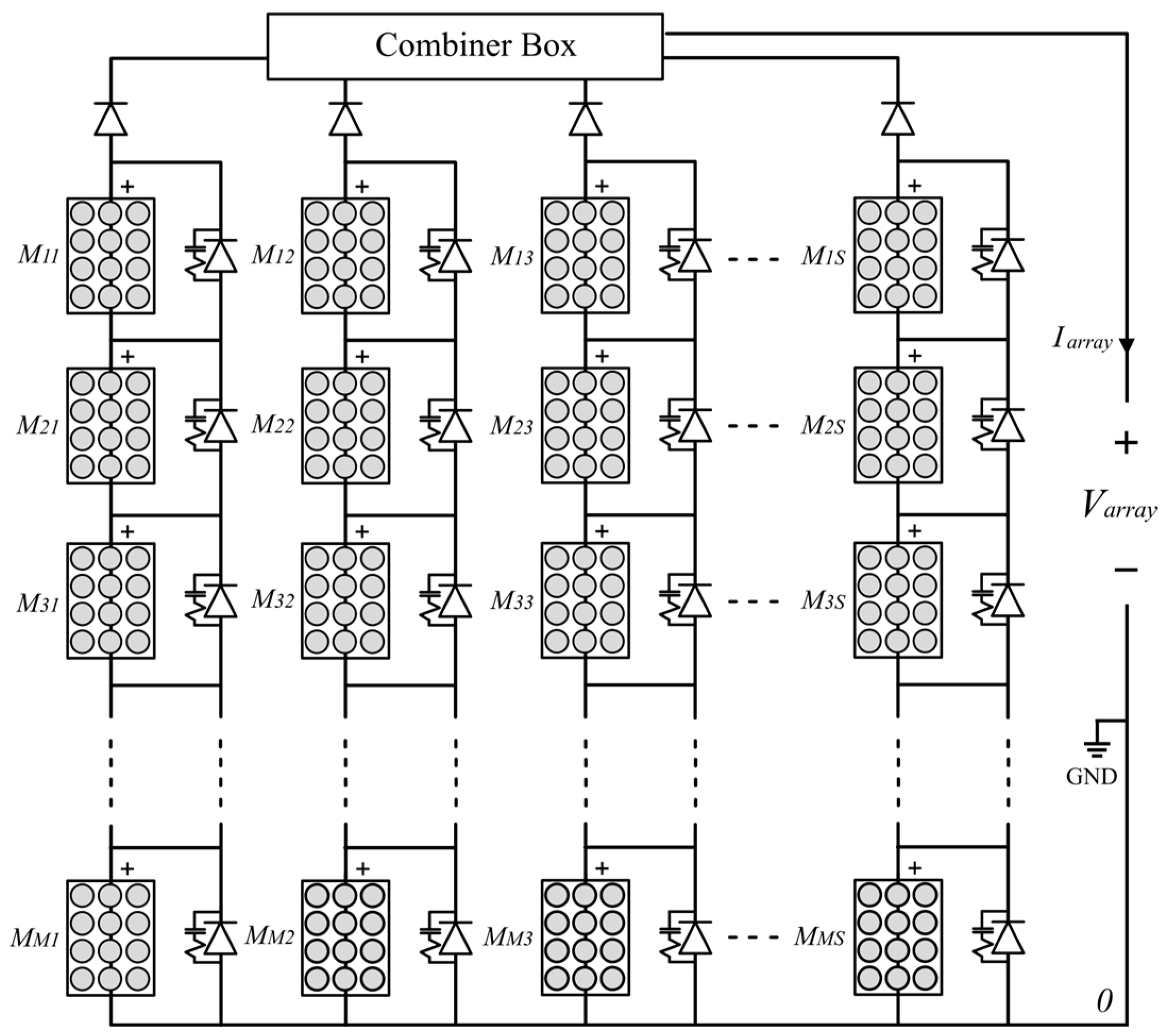
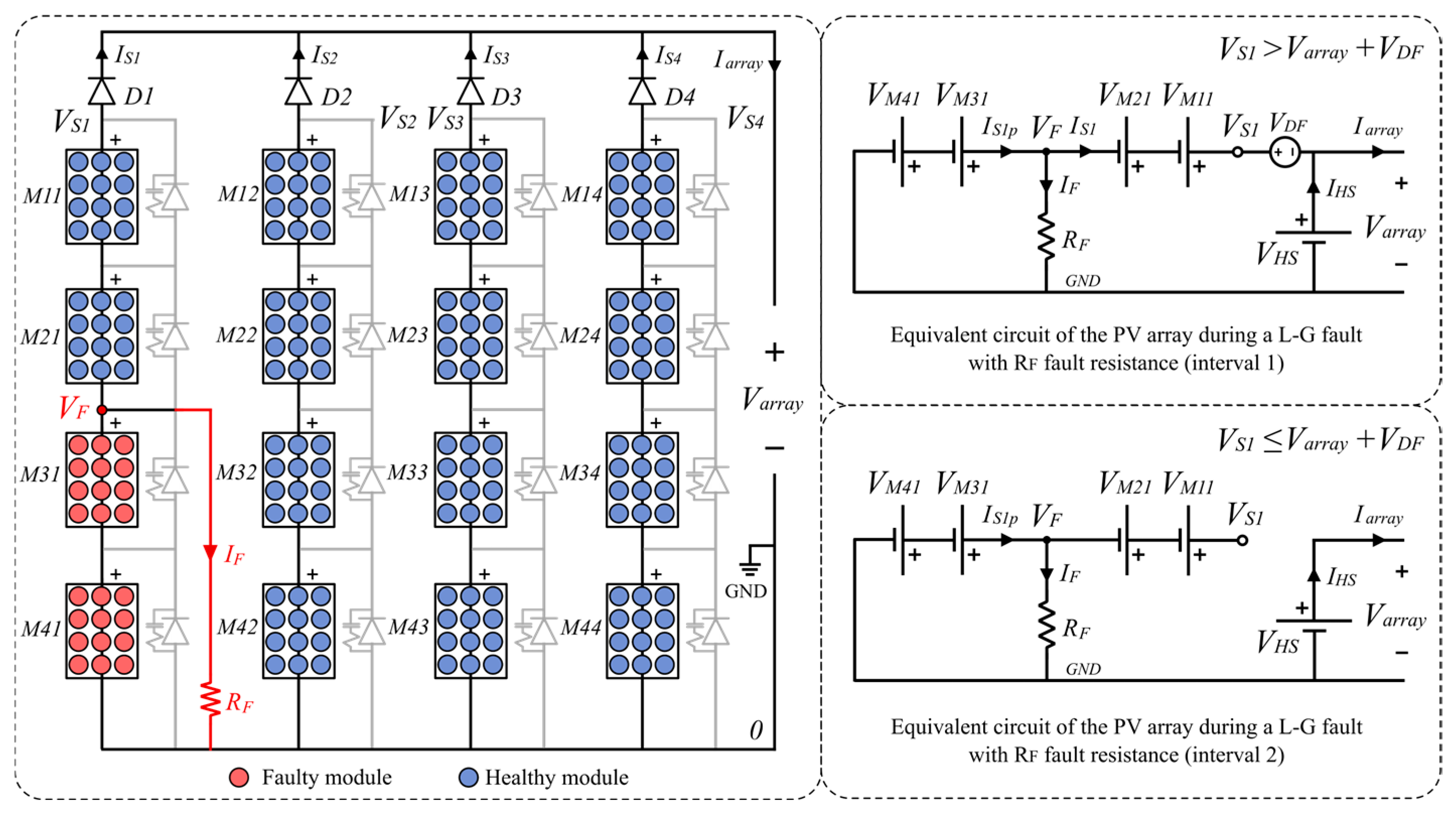


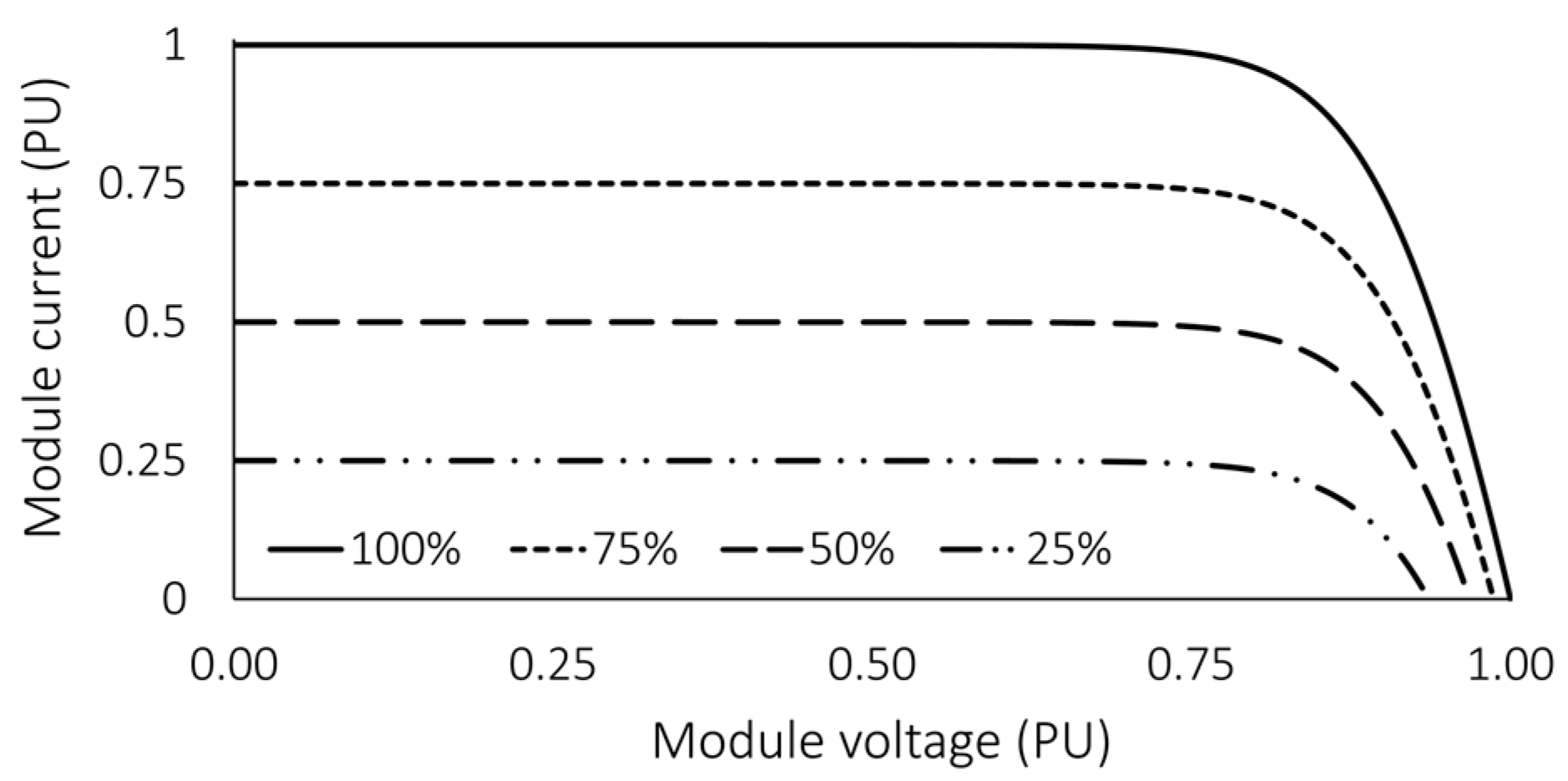

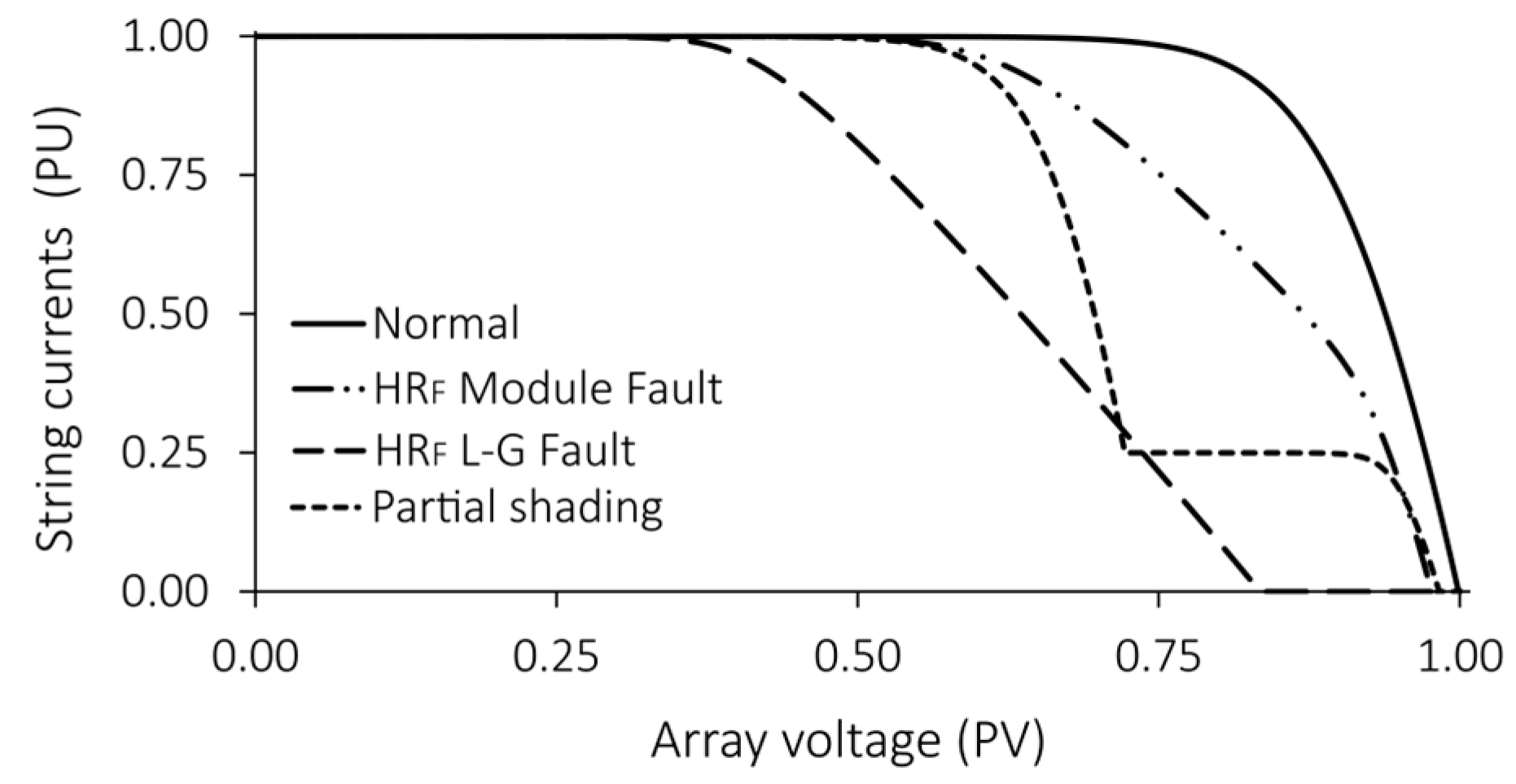
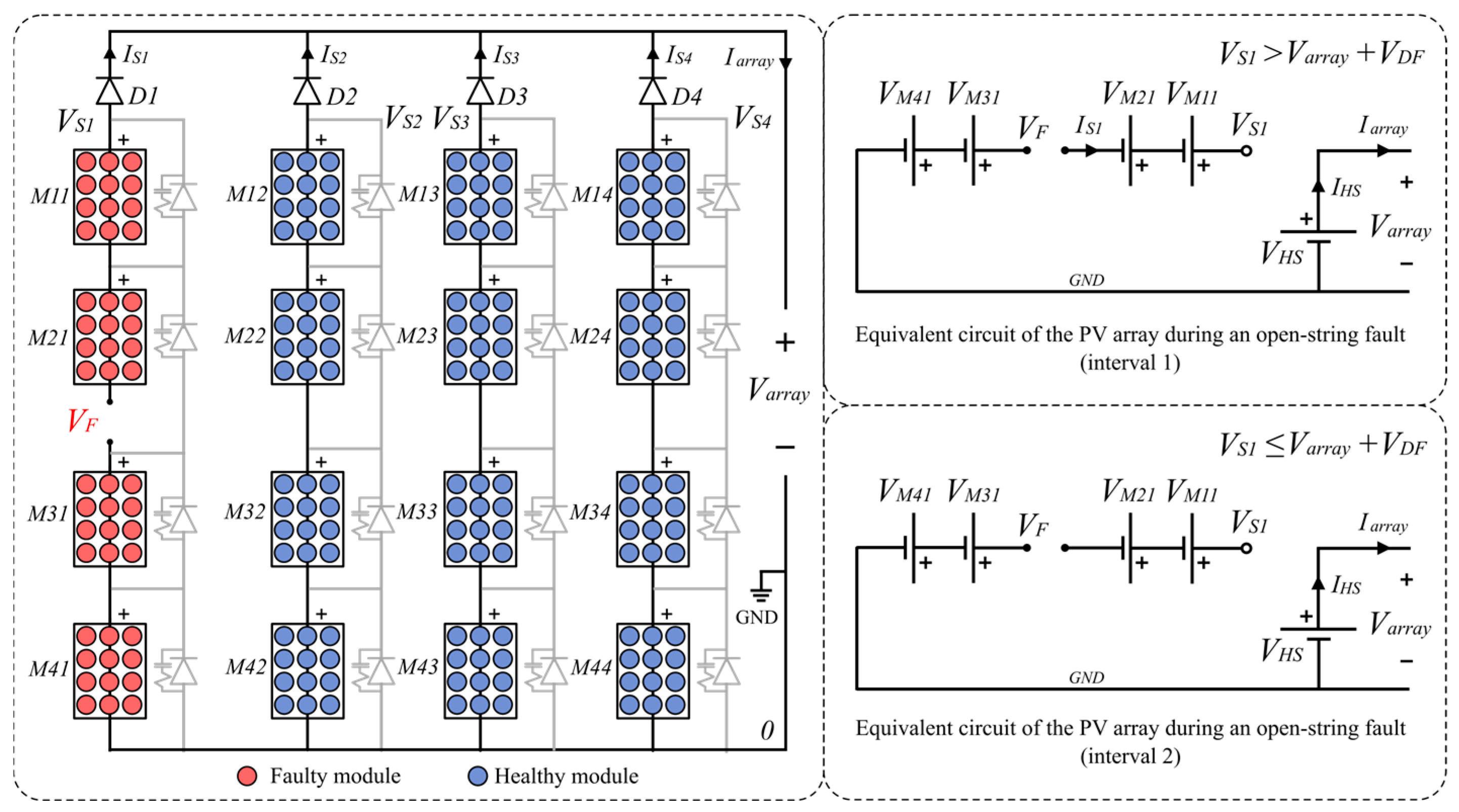



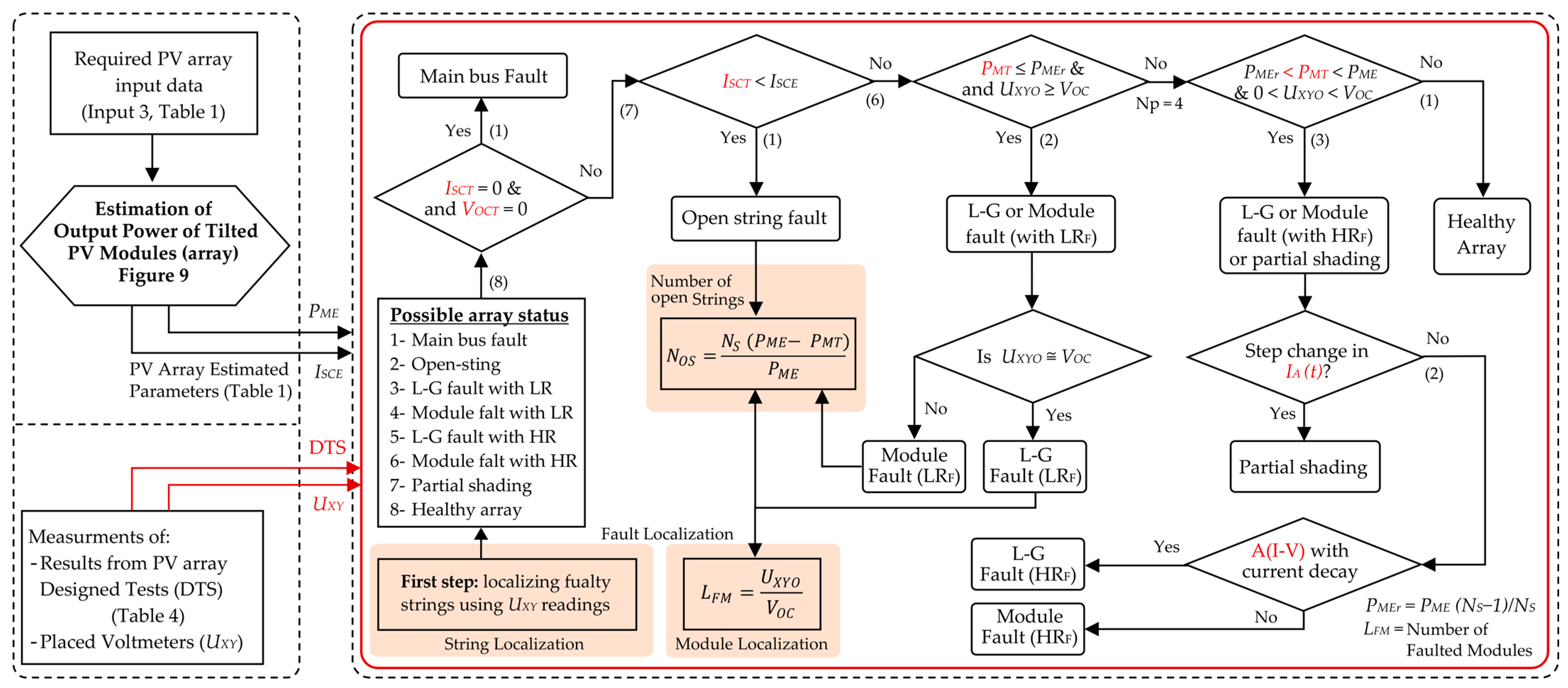



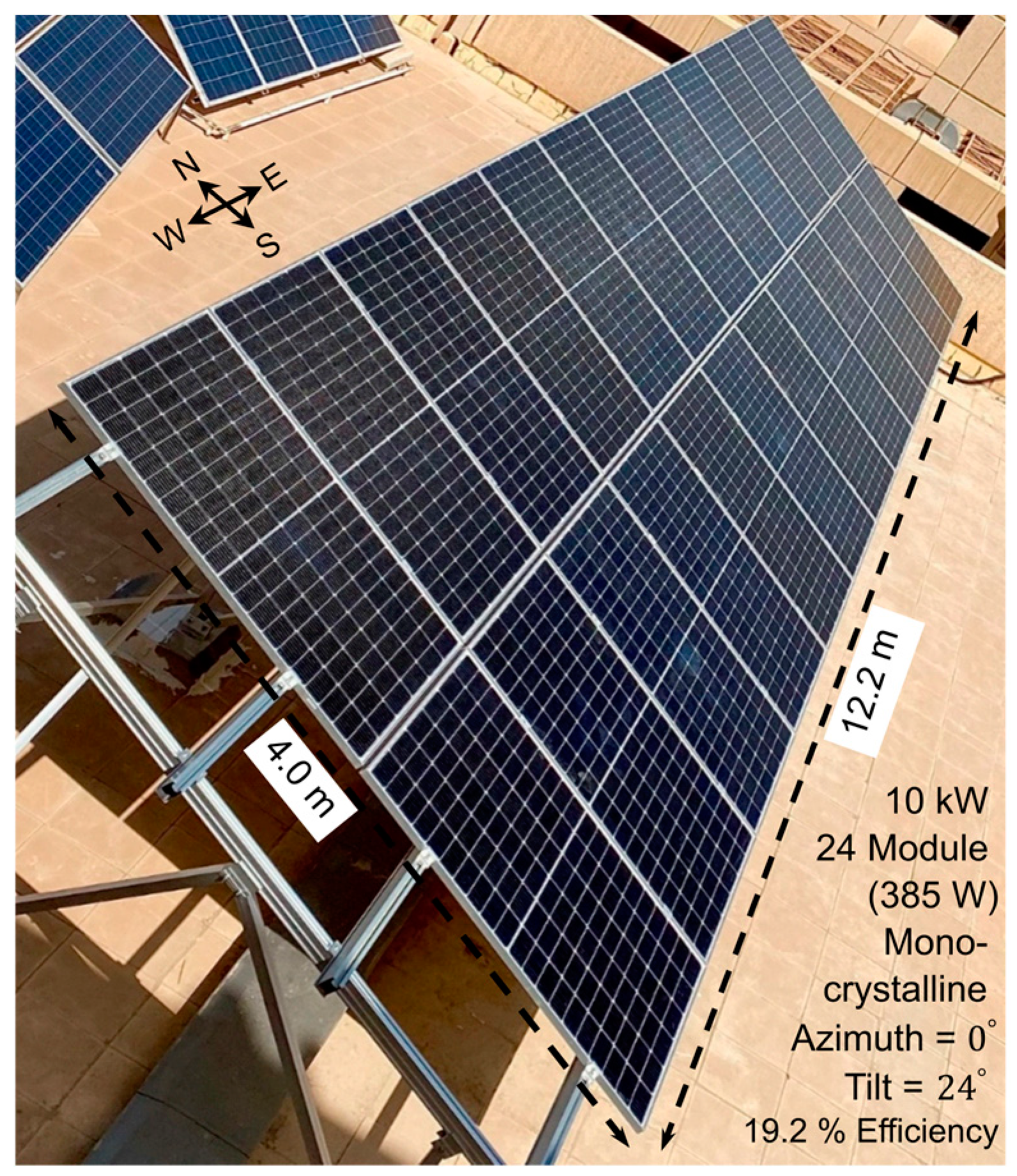
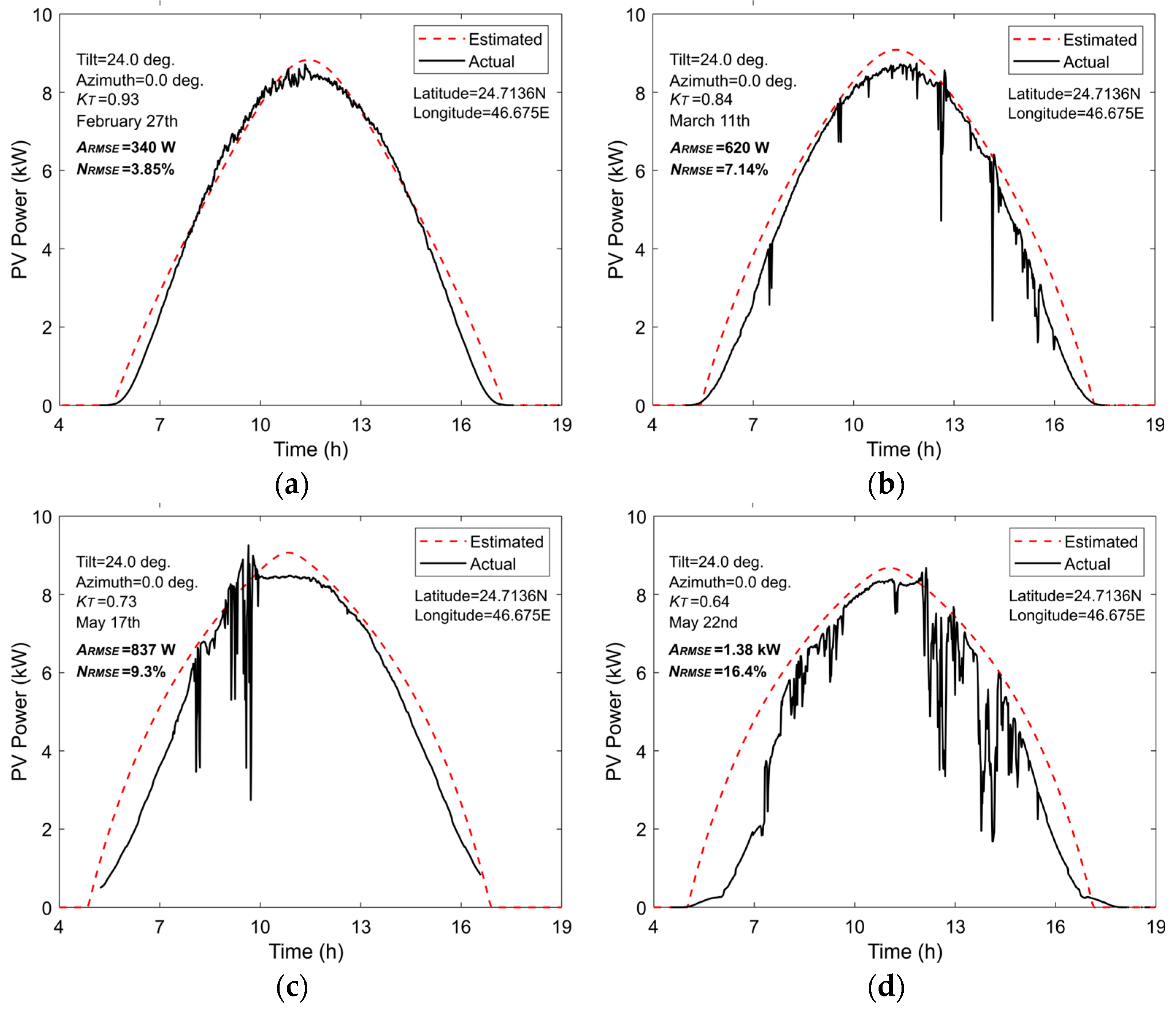


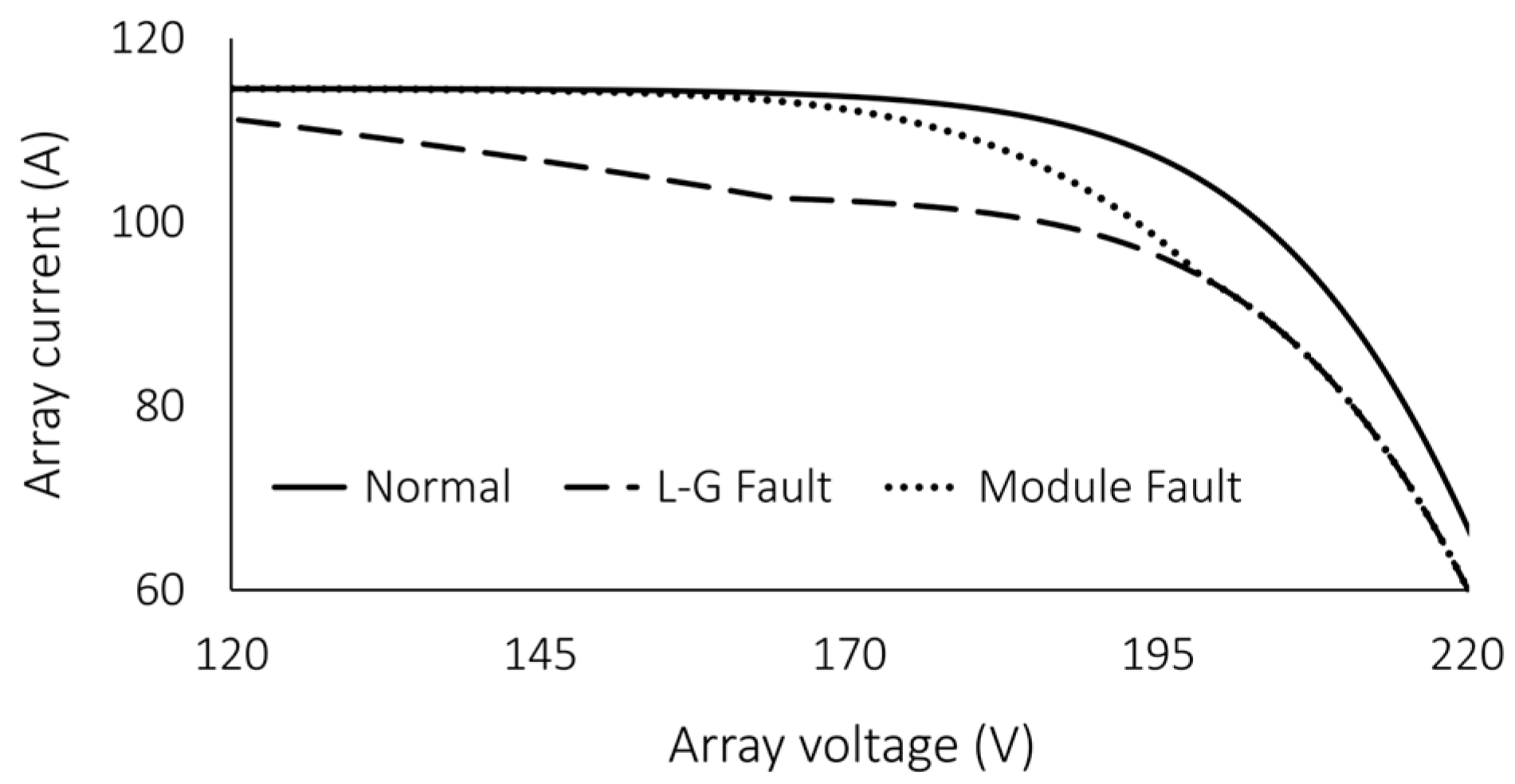


| Approach | Concept | Advantages | Limitations |
|---|---|---|---|
| Virtual imaging | Capturing thermal images of PV modules using infrared cameras |
|
|
| Signal analysis | Interpreting output signals using mathematical techniques and recorded measurements. |
|
|
| I–V curve analysis | Comparing faulty modules with healthy ones based on their I–V curves |
|
|
| Statistical monitoring | Comparing performance data to real measurements. Establishing acceptance/rejection criteria based on a dataset |
|
|
| Using I–V sensors | Using sensors corresponding to each module in the strings to measure the module’s voltage and current patterns |
|
|
| Using power switches | Using switches corresponding to each module |
|
|
| ML and AI methods | Enable computers to learn from previous experiences automatically, such as databases, without explicit human programming |
|
|
| Test Type | Description | Collected Parameters | Symbol |
|---|---|---|---|
| Short-circuit test | Measuring the array actual current under a PV array short-circuit (or very small resistance) condition | Array short-circuit test current | ISCT |
| Open-circuit test | Measuring the array’s actual terminal voltage under an open-circuit condition | Array open-circuit test voltage | VOCT |
| Variable voltage test | Obtaining the array’s I–V curve and transient behavior of actual terminal power and current, with utilizing a variable DC voltage source. At the voltage magnitude associated with the array’s maximum power point, power, voltage, and current can also be collected | Array I–V curve Array transient current Array transient terminal voltage MPPT transient power | A(I–V) IA (t) VA (t) PMT (t) |
| Array Status | Conditions | Explanation and Classification |
|---|---|---|
| Health array | PMT = PME 1 ISCT = ISCE 2 | The essential test parameters to detect array faults are the terminal current and voltage (or power). If these two parameters are as expected, all strings are not experiencing any type of fault |
| Fault at main bus | ISCT = 0 VOCT = 0 | Based on the above condition, if the array current and voltage are both not existing, all strings are experiencing an L–G fault. This scenario is possible when the main array bus (or combiner box) is under fault |
| Open-string fault | ISCT < ISCE | All modules (and bypass diodes) are capable of passing the short-circuit current. This is true under all array conditions, except the open-string condition. Therefore, any reduction in the sort-circuit current is considered a sign of an open-string fault |
| L–G fault with LRF | PMT ≤ PMEr 3 UXYO ≥ 2VOC | During HRF L–G faults, the series diode of the faulty string will become reverse biased; hence, the array MPPT power will be less than the expected power by NFS/NS, where NFS is the number of faulty strings. The voltage difference between the healthy and faulty strings roughly equals a multiple of the open-circuit voltage (mVOC), based on the fault location. The index m is an integer number greater than 1, where (m = 1) represents a L–G fault across the bottom module, meaning a module fault type |
| L–G fault with HRF | PMEr ≤ PMT ≤ PME 0 < UXYO < VOC A(I–V) with a current decay | During HRF L–G faults, the faulty string series diode will remain forward biased. So, the array MPPT power lies between PME and PMEr. The voltage difference between the healthy and faulty strings will not exceed the open-circuit voltage under any array operating point. The HRF L–G fault can be differentiated from module faults and partial shading by analyzing the array I–V curve, as discussed in Section 3 |
| Module fault with LRF | PMT ≤ PMEr UXYO ≈ VOC | The first condition here is similar to the first condition of the L–G fault with LRF. The module fault here can be differentiated from L–G with LRF faults by the string voltage difference, which approximately equals the open-circuit voltage, where only one module within a string will be short-circuited, as discussed in Section 3. |
| Module fault with HRF | PMT < PME 0 < UXYO < VOC A(I–V) with a special pattern | The first two conditions here are similar to the first two conditions of the L–G fault with HR. The module fault here can be differentiated from L–G with HR faults by analyzing the array I–V curve, as discussed in Section |
| Module partial shading | PMT < PME 0 < UXYO < VOC A(I–V) with a current step | The first two conditions here are similar to the first two conditions of the L–G fault with HR. The module partial shading can be differentiated from L–G and module faults with HR by analyzing the array I–V curve, as discussed in Section 3 |
| Data Type | Classification | Name | Parameters |
|---|---|---|---|
| Input data (collected) | Location and time information | Input 1 |
|
| PV module specifications | Input 2 |
| |
| PV system specifications | Input 3 |
| |
| Input data (measured) | Weather factors | Input 4 |
|
| Output data (Estimated) | PV array outputs | Output 1 |
|
| Orientation 1 | Orientation 2 | Orientation 3 | |
|---|---|---|---|
| Tilt angle | 0 degree | 24 degree | 24 degree |
| Azimuth angle | 0 degree | 0 degree | 45 degree |
| Parameter | Value | Parameter | Value |
|---|---|---|---|
| Maximum power (Pmax) | 385 W | Module efficiency | 19.2% |
| Open-circuit voltage (VOC) | 39.82 V | Maximum power voltage (Vm) | 32.65 V |
| Short-circuit current (ISC) | 12.52 A | Maximum power current (Im) | 11.79 A |
| Temperature coefficient of ISC (βI) | +0.044%/°C | Temperature coefficient of VOC (βV) | −0.272%/°C |
| Temperature coefficient of Pmax (βP) | 22120.350%/°C | STC | 1000 W/m2 and 25 °C |
| Location coordinators | (24.7136° N, 46.6753° E) | Module orientation | Tilt angle: 24°, azimuth: 0° |
| Module size | 2.10 m × 1.05 m | Ambient temperature | 35 °C |
| Method | Number of Components | Detects HRF 1 Fault? | Detects LRF 2 Fault? | Component to Module Ratio | Reference Module? | Cost | Module Level | ||
|---|---|---|---|---|---|---|---|---|---|
| Voltage Sensors | Switches | Diodes | |||||||
| [45] | 90 | 0 | 0 | Yes | Yes | 90% | Yes | Very high | Yes |
| [23] | 1 | 50 | 0 | Yes | Yes | 51% | Yes | High | Yes |
| [46] | 50 | 0 | 0 | Yes | Yes | 50% | Yes | Very high | Yes |
| [7] | 45 | 0 | 0 | Yes | Yes | 45% | Yes | High | Yes |
| [47] | 45 | 0 | 0 | Yes | Yes | 45% | Yes | High | Yes |
| [22] | 3 | 0 | 39 | Yes | Yes | 42% | Yes | Medium | Yes |
| [48] | 20 | 0 | 0 | No | Yes | 20% | Yes | Medium | No |
| Proposed | 5 | 0 | 0 | Yes | Yes | 5% | No | Low | Yes |
Disclaimer/Publisher’s Note: The statements, opinions and data contained in all publications are solely those of the individual author(s) and contributor(s) and not of MDPI and/or the editor(s). MDPI and/or the editor(s) disclaim responsibility for any injury to people or property resulting from any ideas, methods, instructions or products referred to in the content. |
© 2024 by the authors. Licensee MDPI, Basel, Switzerland. This article is an open access article distributed under the terms and conditions of the Creative Commons Attribution (CC BY) license (https://creativecommons.org/licenses/by/4.0/).
Share and Cite
Alfaris, F.E.; Al-Ammar, E.A.; Ghazi, G.A.; AL-Katheri, A.A. A Cost-Effective Fault Diagnosis and Localization Approach for Utility-Scale PV Systems Using Limited Number of Sensors. Sustainability 2024, 16, 6454. https://doi.org/10.3390/su16156454
Alfaris FE, Al-Ammar EA, Ghazi GA, AL-Katheri AA. A Cost-Effective Fault Diagnosis and Localization Approach for Utility-Scale PV Systems Using Limited Number of Sensors. Sustainability. 2024; 16(15):6454. https://doi.org/10.3390/su16156454
Chicago/Turabian StyleAlfaris, Faris E., Essam A. Al-Ammar, Ghazi A. Ghazi, and Ahmed A. AL-Katheri. 2024. "A Cost-Effective Fault Diagnosis and Localization Approach for Utility-Scale PV Systems Using Limited Number of Sensors" Sustainability 16, no. 15: 6454. https://doi.org/10.3390/su16156454







